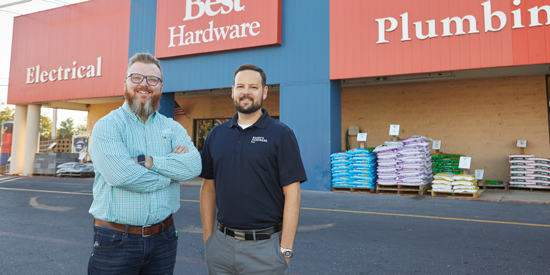More than just a buzzword, omnichannel strategies are driving the future of retail, as the lines between brick-and mortar and online have blurred and customers expect businesses to meet them where they are. Whether online or in-person, commerce is commerce and retailers need to embrace both.
At Randy’s Hardware, which has four locations in Virginia, Austin Diehl, director of retail operations, calls his operation’s approach to building a digital presence the “hub and spoke” model. The goal of this model is to utilize as many digital platforms as possible to expand the company’s digital reach and drive traffic to the operation’s website, which includes information for all four locations on one website.
The Challenge of Content Creation
 Creating content for various channels takes time and effort, so to cut down on both and become more efficient, Diehl says the team has been creating content that can be used as long-form, medium-form, short-form and stand alone posts on social media.
Creating content for various channels takes time and effort, so to cut down on both and become more efficient, Diehl says the team has been creating content that can be used as long-form, medium-form, short-form and stand alone posts on social media.
“This strategy allows us to use the same base content across multiple sites while still reaching our audience in the way that they prefer to consume media,” Diehl says.
No matter which platform the company disseminates information on, the ultimate goal is to maintain consistent
messaging and continuity across all platforms, Diehl says.
To help achieve this goal, Randy’s Hardware has hired a marketing coordinator, Sarah Berry. The operation also partners with a local marketing company that provides guidance and monitors results. Diehl says the marketing team does most of the content creation and application while the agency acts as a marketing advisor. Utilizing the agency as an advisor and creating their own content keeps costs down because Randy’s Hardware doesn’t have to pay for the full agency services.
“There are also many free resources available online, including on the NHPA website for those interested in expanding their knowledge of marketing,” Diehl says.
A Strategy Is Born
Before you can start building a digital presence, you need to begin identifying its customer base and audience demographics. From there, find out what platforms those target audiences use and build the digital marketing plan from there.
Next, Diehl says it’s important to develop a marketing budget and determine if hiring a marketing person is in your budget. According to the North American Hardware and Paint Association’s 2023 Cost of Doing Business Study, typical hardware stores spend about 1.4% of their annual sales on advertising and promotion.
“We have found it is difficult to run the day-to-day operations and create content to use in our marketing plan,” Diehl says. “Just posting on Facebook or Instagram whenever you have time isn’t an effective strategy. Different types of posts perform differently depending on the time of the day and the day of the week it is posted.”
If a dedicated marketing person isn’t in the budget, Diehl suggests being strategic with carving out time to do it yourself and plan time every week to create content and use the scheduling functions on social platforms to make sure your content is being delivered to your audience at the right time.
“Creating content that can be used across multiple platforms will be a more efficient use of your budgeted time and efforts,” Diehl says. “Keep in mind that the content you’ve created may perform better on one platform versus another. It is important to check in on how your posts are doing using the platform’s analytics tools to identify trends and adjust accordingly. This may seem overwhelming for some, and it did at first for me too, but if you can identify trends in your stores, you can identify trends in marketing.”
The Hub Spokes Work Together
 An effective digital strategy will take more than just social media posts or a website; all of the spokes in the hub need to complement one another and work in tandem. For Randy’s Hardware, the website is the hub of the marketing wheel and the other types of digital marketing are the spokes. Each spoke is a separate advertising channel or marketing platform used to drive additional traffic to the operation’s e-commerce website. Once customers come to the e-commerce website, they have are presented with two buying options: buy online and have the product shipped to them or choose to pick it up in-store.
An effective digital strategy will take more than just social media posts or a website; all of the spokes in the hub need to complement one another and work in tandem. For Randy’s Hardware, the website is the hub of the marketing wheel and the other types of digital marketing are the spokes. Each spoke is a separate advertising channel or marketing platform used to drive additional traffic to the operation’s e-commerce website. Once customers come to the e-commerce website, they have are presented with two buying options: buy online and have the product shipped to them or choose to pick it up in-store.
“When they choose to pick it up at our store, we have the opportunity to showcase our brand of shopping experience,” Diehl says. “We make the process as frictionless as possible in hopes that the customer will buy into our brand and continue shopping with us in the future.”
Diehl says the company’s digital marketing strategy, e-commerce website and in-store experience all have to work together to deliver the Randy’s Hardware brand experience wherever customers engage with the company. The evolution of brick-and-mortar retail necessitates operating in the physical and the digital spaces.
“We are trying to blur the line between brick-and-mortar and online retail,” Diehl says. “Ultimately our goal would be for customers to be able to seamlessly shop however and whenever they want while still receiving our full brand experience.”
Diehl is also exploring going beyond traditional digital hubs, and the team is working with the marketing agency to produce YouTube videos. Right now, the videos are a mix of DIY project ideas, store event highlights and other high points from the stores.
“We want to tell our story and be more than just a place to go buy products,” Diehl says. “We want to build a brand people want to support.”
 Hardware Retailing The Industry's Source for Insights and Information
Hardware Retailing The Industry's Source for Insights and Information






